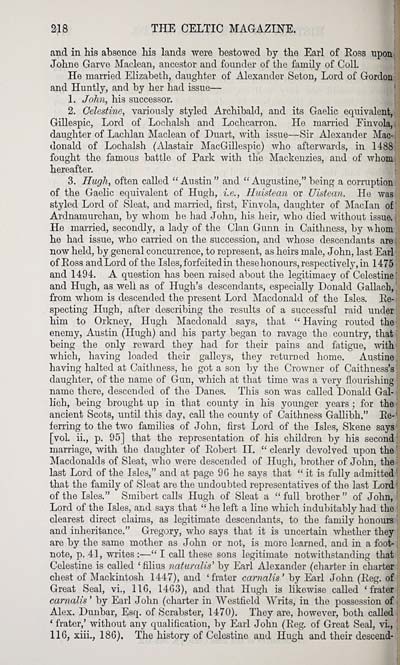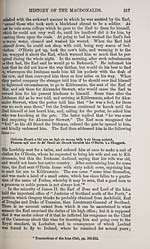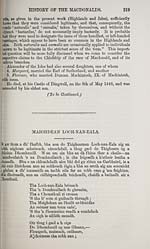Blair Collection > Celtic magazine > Volume 5
(228)
Download files
Complete book:
Individual page:
Thumbnail gallery: Grid view | List view

218 THE CELTIC MAGAZmE. i
and in his absence his lands were bestowed by the Earl of Eoss uponj j
Johne Garve Maclean, ancestor and founder of the family of Coll. :
He married Elizabeth, daughter of Alexander Seton, Lord of Gordon- :
and Huntly, and by her had issue —
1. John, his successor,
2. Celestine, variously styled Archibald, and its Gaelic equivalent)
Gillespie, Lord of Lochalsh and Lochcarron. He married EinvolaJ*
daughter of Lachlan Maclean of Duart, with issue — Sir Alexander Mac-
donald of Lochalsh (Alastair MacGillespic) who afterwards, in 1488-
fought the famous battle of Park with the Mackenzies, and of whom^
hereafter.
3. Hugh, often called " Austin " and " Augustine," being a corruption
of the Gaelic equivalent of Hugh, i.e., Huistean or Uistean. He was
styled Lord of Sleat, and married, first, Finvola, daughter of Maclan of
Ardnamurchan, by whom he had John, his heir, who died without issue.
He married, secondly, a lady of the Clan Gunn in Caithness, by -whom
he had issue, who carried on the succession, and whose descendants are
now held, by general concurrence, to represent, as heirs male, John, last Earl
of Eoss and Lord of the Isles, forfeited in thesehonours, respectively, in 1475
and 1494. A question has been raised about the legitimacy of Celestine
and Hugh, as well as of Hugh's descendants, especially Donald GaUach,
from whom is descended the present Lord Macdonald of the Isles. Ee-
specting Hugh, after describing the results of a successful raid under
him to Orkney, Hugh Macdonald says, that " Havmg routed the
enemy, Austin (Hugh) and his party began to ravage the country, that,
being the only reward they had for their pains and fatigue, with
which, having loaded their galleys, they re turned home. Austine
having halted at Caithness, he got a son by the Crowner of Caithness's
daughter, of the name of Gun, which at that time was a very flourishing
name there, descended of the Danes. This son was called Donald Gal-
lich, being brought up in that county in his younger years ; for the'
ancient Scots, until this day, call the county of Caithness Gallibh," Ee-
ferring to the two families of John, first Lord of the Isles, Skene says
[voL ii., p, 95] that the representation of his children by his second
marriage, with the daughter of Eobert II. " clearly devolved upon the
IMacdonalds of Sleat, who were descended of Hugh, brother of John, the
last Lord of the Isles," and at page 9G he says that " it is fully admitted^l
that the family of Sleat are the undoubted representatives of the last Lord "
of the Isles." Smibert calls Hugh of Sleat a " full brother " of John,
Lord of the Isles, and says that " he left a line which indubitably had the
clearest direct claims, as legitimate descendants, to the family honours^
and inheritance." Gregory, who says that it is uncertain whether they
are by the same mother as John or not, is more learned, and in a foot-
note, p. 41, writes : — " I caU these sons legitimate notwithstanding that
Celestine is called 'filius natural is' by Earl Alexander (charter in charter
chest of Mackintosh 1447), and 'frater carnalis' by Earl John (Eeg. of
Great Seal, vi., 116, 14G3), and that Hugh is likewise called 'fratei
carnah's ' by Earl John (charter in Westfield Writs, in the possession of
Alex. Dunbar, Esq. of Scrabster, 1470). They are, however, both called
' frater,' without any qualification, by Earl John (Eeg. of Great Seal, vi,
116, xiii., 186). The history of Celestine and Hugh and their descend-
and in his absence his lands were bestowed by the Earl of Eoss uponj j
Johne Garve Maclean, ancestor and founder of the family of Coll. :
He married Elizabeth, daughter of Alexander Seton, Lord of Gordon- :
and Huntly, and by her had issue —
1. John, his successor,
2. Celestine, variously styled Archibald, and its Gaelic equivalent)
Gillespie, Lord of Lochalsh and Lochcarron. He married EinvolaJ*
daughter of Lachlan Maclean of Duart, with issue — Sir Alexander Mac-
donald of Lochalsh (Alastair MacGillespic) who afterwards, in 1488-
fought the famous battle of Park with the Mackenzies, and of whom^
hereafter.
3. Hugh, often called " Austin " and " Augustine," being a corruption
of the Gaelic equivalent of Hugh, i.e., Huistean or Uistean. He was
styled Lord of Sleat, and married, first, Finvola, daughter of Maclan of
Ardnamurchan, by whom he had John, his heir, who died without issue.
He married, secondly, a lady of the Clan Gunn in Caithness, by -whom
he had issue, who carried on the succession, and whose descendants are
now held, by general concurrence, to represent, as heirs male, John, last Earl
of Eoss and Lord of the Isles, forfeited in thesehonours, respectively, in 1475
and 1494. A question has been raised about the legitimacy of Celestine
and Hugh, as well as of Hugh's descendants, especially Donald GaUach,
from whom is descended the present Lord Macdonald of the Isles. Ee-
specting Hugh, after describing the results of a successful raid under
him to Orkney, Hugh Macdonald says, that " Havmg routed the
enemy, Austin (Hugh) and his party began to ravage the country, that,
being the only reward they had for their pains and fatigue, with
which, having loaded their galleys, they re turned home. Austine
having halted at Caithness, he got a son by the Crowner of Caithness's
daughter, of the name of Gun, which at that time was a very flourishing
name there, descended of the Danes. This son was called Donald Gal-
lich, being brought up in that county in his younger years ; for the'
ancient Scots, until this day, call the county of Caithness Gallibh," Ee-
ferring to the two families of John, first Lord of the Isles, Skene says
[voL ii., p, 95] that the representation of his children by his second
marriage, with the daughter of Eobert II. " clearly devolved upon the
IMacdonalds of Sleat, who were descended of Hugh, brother of John, the
last Lord of the Isles," and at page 9G he says that " it is fully admitted^l
that the family of Sleat are the undoubted representatives of the last Lord "
of the Isles." Smibert calls Hugh of Sleat a " full brother " of John,
Lord of the Isles, and says that " he left a line which indubitably had the
clearest direct claims, as legitimate descendants, to the family honours^
and inheritance." Gregory, who says that it is uncertain whether they
are by the same mother as John or not, is more learned, and in a foot-
note, p. 41, writes : — " I caU these sons legitimate notwithstanding that
Celestine is called 'filius natural is' by Earl Alexander (charter in charter
chest of Mackintosh 1447), and 'frater carnalis' by Earl John (Eeg. of
Great Seal, vi., 116, 14G3), and that Hugh is likewise called 'fratei
carnah's ' by Earl John (charter in Westfield Writs, in the possession of
Alex. Dunbar, Esq. of Scrabster, 1470). They are, however, both called
' frater,' without any qualification, by Earl John (Eeg. of Great Seal, vi,
116, xiii., 186). The history of Celestine and Hugh and their descend-
Set display mode to: Large image | Transcription
Images and transcriptions on this page, including medium image downloads, may be used under the Creative Commons Attribution 4.0 International Licence unless otherwise stated. ![]()
| Early Gaelic Book Collections > Blair Collection > Celtic magazine > Volume 5 > (228) |
|---|
| Permanent URL | https://digital.nls.uk/76451560 |
|---|
| Description | Volume V, 1880. |
|---|---|
| Shelfmark | Blair.6 |
| Attribution and copyright: |
|
| Description | A selection of books from a collection of more than 500 titles, mostly on religious and literary topics. Also includes some material dealing with other Celtic languages and societies. Collection created towards the end of the 19th century by Lady Evelyn Stewart Murray. |
|---|
| Description | Selected items from five 'Special and Named Printed Collections'. Includes books in Gaelic and other Celtic languages, works about the Gaels, their languages, literature, culture and history. |
|---|

